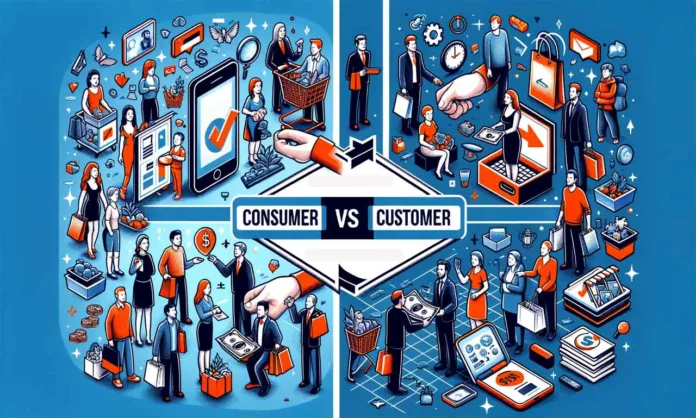In the realm of business and marketing, the terms “consumer” and “customer” are often used interchangeably. However, understanding the distinction between the two is crucial for businesses aiming to tailor their strategies effectively. This article delves into the differences between consumers and customers, providing insights that can help businesses in targeting, product development, marketing, and sales strategies.

Table of Contents
Consumer vs Customer
| Aspect | Consumer | Customer |
| Definition | A consumer is an individual who uses or consumes a product or service. | A customer is an individual or entity that purchases a product or service. |
| Role | Consumers are the end-users of a product or service. They may not necessarily purchase the product themselves. | Customers are the buyers, regardless of whether they use the product or service themselves. |
| Example | A child playing with a toy purchased by their parent. | The parent who bought the toy for their child. |
| Focus in Marketing | Marketing strategies targeting consumers often focus on the benefits, usage, and satisfaction derived from the product or service. | Marketing strategies targeting customers often emphasize price, value, and purchase conditions. |
| Engagement | Consumer engagement may focus on user experience, product feedback, and loyalty programs. | Customer engagement may involve purchase incentives, customer service, and sales promotions. |
| Decision Making | Consumers’ decisions may be influenced by personal preferences, social factors, and emotional connections. | Customers’ decisions may be influenced by price, product features, and return policies. |
| Importance in Business Strategy | Understanding consumers is essential for product development, branding, and creating a positive user experience. | Understanding customers is crucial for sales strategies, distribution channels, and pricing models. |
Steps to Differentiate Between Consumer and Customer in Business Strategy
Step 1: Identify Your Target Audience
- For Consumers: Focus on the end-users’ demographics, lifestyle, and consumption habits.
- For Customers: Analyze the buying behavior, purchase decision factors, and demographics of the purchaser.
Step 2: Tailor Your Product or Service
- For Consumers: Ensure the product meets the end-user’s needs, preferences, and expectations.
- For Customers: Design your offering to appeal to the buyer’s value perception, emphasizing quality, price, and convenience.
Step 3: Develop Your Marketing Strategy
- For Consumers: Create campaigns that resonate with the end-users’ emotions, preferences, and the benefits they seek from using the product.
- For Customers: Develop marketing messages that highlight the value proposition, cost-effectiveness, and purchase incentives.
Step 4: Optimize Your Sales Approach
- For Consumers: Implement strategies that enhance the user experience, such as personalized recommendations and post-purchase support.
- For Customers: Focus on efficient distribution channels, competitive pricing, and responsive customer service.
Step 5: Foster Relationships and Loyalty
- For Consumers: Engage with end-users through feedback channels, loyalty programs, and community building.
- For Customers: Maintain a strong relationship with buyers through excellent customer service, rewards for repeat purchases, and responsive communication.
Conclusion
Understanding the distinction between consumers and customers is pivotal for businesses aiming to refine their marketing and sales strategies. By recognizing the unique needs, preferences, and decision-making processes of each group, businesses can tailor their approaches to effectively engage both consumers and customers, ultimately leading to enhanced satisfaction, loyalty, and business success.
Frequently Asked Questions (FAQ)
What is the primary difference between a consumer and a customer?
The primary difference lies in their roles regarding a product or service. A consumer is the end-user who utilizes or consumes the product, whereas a customer is the one who purchases it. The customer may or may not be the consumer.
Can a person be both a consumer and a customer?
Yes, a person can be both a consumer and a customer when they purchase a product or service for their own use. For instance, buying and drinking a cup of coffee makes one both the customer (the buyer) and the consumer (the one who drinks it).
Why is it important for businesses to distinguish between consumers and customers?
Understanding this distinction helps businesses tailor their marketing, sales, and product development strategies more effectively. By targeting each group’s specific needs and preferences, businesses can enhance user experience, customer satisfaction, and ultimately, loyalty and profitability.
How can businesses effectively target both consumers and customers?
Businesses can target both groups by developing comprehensive strategies that address each group’s needs. For consumers, the focus should be on product quality, user experience, and emotional engagement. For customers, strategies should emphasize value, convenience, and purchase incentives.
In what ways can the confusion between consumers and customers impact a business?
Confusing consumers with customers can lead to misdirected marketing efforts, ineffective sales strategies, and product misalignments. This can result in reduced customer satisfaction, diminished brand loyalty, and ultimately, a negative impact on sales and profitability.
How can businesses measure the effectiveness of their strategies towards consumers and customers?
Businesses can measure effectiveness through various metrics, such as customer satisfaction scores, consumer feedback, repeat purchase rates, and engagement levels on marketing campaigns. Regularly analyzing these metrics can help businesses adjust their strategies for better alignment with consumer and customer needs.
